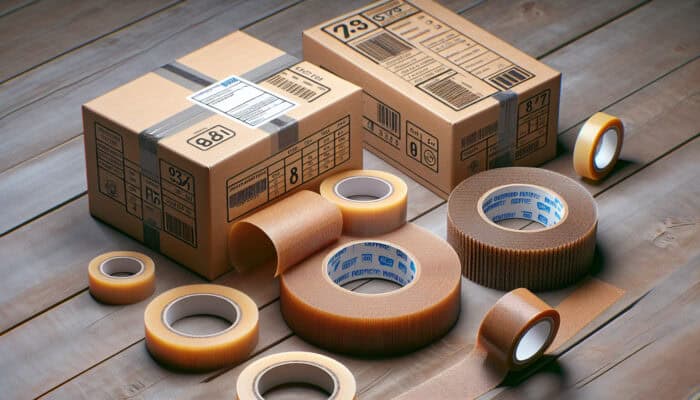Introduction to Packing Tape for House Clearance
Types of Packing Tape

Packing Tape Essentials for House Clearance: Packing tape is an essential tool in the process of house clearance, and it comes in various forms tailored to meet specific needs. The most common types include clear tape, brown tape, and reinforced tape. Clear tape is versatile and is often used for general packing purposes, as it allows the contents of the box to be visible. It’s particularly useful when labelling boxes because you can easily see the contents without opening them. Brown tape, on the other hand, is made from kraft paper and is preferred for its strength and aesthetic, often giving boxes a more professional look. Reinforced tape is designed for heavy-duty use and features fibres embedded within the tape, providing extra strength and durability, making it ideal for heavy or fragile items.
Choosing the right type of tape can make all the difference during a house clearance. For instance, if you are packing lighter items, the clear or brown tape would suffice. However, when handling heavy objects or delicate items like glassware, opting for reinforced tape can prevent unfortunate mishaps during transport.
Importance of Quality Packing Tape
Utilising high-quality packing tape is imperative to ensure the safety of your belongings during a house clearance. When boxes are securely sealed with quality tape, the risk of damage is significantly reduced. Subpar tape can easily break or lose adhesion, leading to boxes bursting open or items shifting within, which could result in breakage or loss of property. Investing in robust packing tape not only protects your items but also provides peace of mind throughout the moving process.
Moreover, quality tape adheres better to various surfaces, ensuring that boxes remain sealed despite the rigours of moving and transport. This is especially important when items are stacked or subjected to vibrations and movements. The right tape can withstand these conditions, making it a vital component of any successful house clearance effort.
How to Choose the Right Packing Tape?
Choosing the right packing tape requires careful consideration of the items you are packing. The weight and fragility of your belongings directly influence the type of tape you should select. For lightweight and non-fragile items, standard clear or brown tape will likely suffice. However, when it comes to heavier or fragile items, it’s essential to look for tape with superior strength and adhesion properties.
Look for tapes with a tensile strength rating that indicates their capacity to hold weight without breaking. Additionally, consider the tape’s width; wider tapes typically provide a stronger seal than narrower options. Another factor is the type of dispenser used for applying the tape; a hand-held dispenser can make the application process smoother and ensure that the tape is applied evenly.
Ultimately, a thorough assessment of your packing needs will help you select the most suitable packing tape. Always err on the side of caution and choose a stronger tape if you have any doubt about the suitability of a particular type.
Best Practices for Using Packing Tape

Applying packing tape effectively is crucial in ensuring that boxes remain securely sealed during transit. Following best practices can greatly enhance the efficiency of your packing process. Firstly, ensure you apply the tape evenly across the seams of the boxes to prevent any weaknesses. This means laying the tape flat, without creases, to maximise adhesion. It’s advisable to apply two to three strips of tape over the seams for added security, particularly on larger boxes.
Additionally, when sealing boxes, ensure that all openings, including the top and bottom flaps, are covered. It’s often helpful to start from the centre of the seam and work outwards, ensuring that the tape adheres smoothly without any bubbles or gaps. When moving heavier items, don’t hesitate to use extra tape; it’s better to use a bit more than risk compromising the safety of your belongings.
- Apply tape evenly and firmly across all seams.
- Use two to three strips for larger or heavier boxes.
- Start from the centre of the seam and work outwards.
- Ensure no gaps or bubbles are present under the tape.
- For fragile items, consider double-taping seams.
- Label boxes clearly after taping to avoid confusion.
- Store tape in a cool, dry place to maintain its adhesive quality.
Environmental Impact of Packing Tape
In today’s environmentally conscious society, the impact of packing materials, including packing tape, is a significant consideration during house clearance. Traditional packing tape is often made from plastic, contributing to landfill waste. This is why it’s essential to consider environmentally friendly options, such as biodegradable or recyclable tapes. These eco-friendly alternatives not only serve the same purpose as traditional packing tape but also offer peace of mind in knowing you are minimising your environmental footprint.
When selecting packing tape, look for products that are labelled as recyclable or made from sustainable materials. Some brands even offer refillable dispensers to reduce waste further. By choosing these options, you contribute to a more sustainable moving process and can inform others about the importance of making eco-conscious decisions during their own clearances.
Opting for eco-friendly tape not only benefits the environment but can also enhance your reputation as a responsible individual or organisation, which is particularly important if you are involved in larger-scale clearances.
Expert Insights on Packing Tape Essentials for House Clearance
What Makes Packing Tape Essential?

Packing tape is an indispensable element of any house clearance effort. It serves the primary function of securely sealing boxes, thereby preventing items from falling out during transit or storage. This security is paramount, particularly when moving fragile or valuable items. A well-sealed box ensures that your belongings are protected from damage, dirt, and moisture, which is vital for maintaining their condition.
Moreover, packing tape simplifies the organisation process. With clear and well-sealed boxes, it becomes easier to label and identify contents quickly, which can save time and reduce stress during a busy moving day. The efficiency of packing tape extends beyond just sealing; it is a fundamental tool that plays a pivotal role in the overall success of a house clearance.
Furthermore, the ease of use that quality packing tape provides can significantly streamline the packing process. Whether you are a seasoned mover or tackling your first house clearance, the right tape can make the task much more manageable.
How Can Experts Help with Packing Tape Selection?
Experts in the moving industry provide invaluable insights when it comes to selecting the appropriate packing tape for various house clearance scenarios. For instance, professional movers often assess the specific needs of each clearance project, considering factors such as the type and quantity of items to be packed, the distance of the move, and the potential hazards during transport.
In real-world scenarios, experts frequently recommend reinforced tape for heavy or fragile items, as it offers additional protection against the rigours of moving. They also might suggest clear tape for lightweight items that do not require as much support but need visibility for easy identification. Through their experience, these professionals can provide tailored advice, ensuring that you select the most suitable tape for your unique circumstances.
Additionally, expert consultations can guide you on the best practices for application, including tips on layering and ensuring a secure seal. This level of expertise can be especially beneficial for those who may not feel confident in their packing skills.
What Are the Best Practices for Using Packing Tape?
Utilising packing tape effectively is crucial in ensuring that your items are well-protected during a house clearance. Best practices not only enhance the security of your boxed items but also improve the overall efficiency of the moving process. One fundamental practice is to apply the tape with sufficient pressure, ensuring that it adheres fully to the box. This prevents the tape from peeling away during transit.
Another significant best practice involves correctly sealing the bottom of boxes before loading them with items. This ensures that the weight of the contents does not cause the box to split open. Additionally, apply tape uniformly to avoid weak points that could lead to box failures.
- Apply tape with firm pressure for better adhesion.
- Always tape the bottom of boxes securely before packing.
- Use enough tape to cover all seams and openings.
- Opt for wider tape for larger boxes to add extra strength.
- Label boxes clearly after sealing to avoid confusion.
- Keep tape dispensers within easy reach for quick access during packing.
- Check the expiry date on tapes to ensure effectiveness.
What Types of Packing Tape Are Best for House Clearance?
Choosing the right type of packing tape can significantly affect the outcome of your house clearance. As discussed, clear tape is suitable for general packing and allows visibility,, but may not provide the necessary strength for heavier items. Brown tape is an excellent choice for those seeking a sturdy option that offers a classic look, making it ideal for packaging fragile or valuable items professionally.
Reinforced tape stands out as the best option for particularly heavy or fragile items, as it combines superior strength with durability. This type of tape is fortified with plastic fibres, making it less likely to tear or break under pressure. Additionally, speciality tapes, such as those designed for specific weather conditions, may be beneficial for long-distance moves, where temperature fluctuations can affect the integrity of standard packing tape.
Ultimately, understanding the specific needs of your items will guide you in selecting the most suitable tape, ensuring your house clearance proceeds smoothly and without incident.
How to Store Packing Tape for Future Use?
Proper storage of packing tape is essential for maintaining its quality and ensuring it remains usable for future house clearance projects. Store tape in a cool, dry environment, away from direct sunlight, as excessive heat can compromise the adhesive properties, making it less effective when needed. Keep the tape in its original packaging or in a dedicated storage box to prevent it from getting tangled or damaged.
If you have multiple rolls, consider using a tape dispenser that allows for easy access and protection against dust and moisture. This not only keeps the tape in good condition but also speeds up the packing process, as you won’t have to fumble through rolls that may have become intertwined.
Regularly check your tape supplies, especially before a planned clearance, to ensure you have adequate quantities of the types you need. Proper storage can significantly prolong the life of packing tape and enhance your packing experience.
Packing Tape and Box Sizes in UK House Clearance
Matching Tape to Box Sizes
Correctly matching tape to box sizes is crucial for a successful house clearance. The amount of tape required varies with box dimensions; smaller boxes typically need less tape than larger ones. A general rule of thumb is to ensure that all seams are covered securely, regardless of the box size.
For small boxes, a few strips of tape may suffice, but for larger boxes, you’ll want to use multiple strips to ensure that the contents remain secure. This not only prevents boxes from bursting open but also adds an extra layer of protection against potential damage during transit. Assessing the size and weight of items being packed will help determine the right amount of tape needed for each box.
By ensuring that you have adequate tape for each box size, you can streamline your packing process, reducing delays and potential frustrations on moving day.
How Much Tape Do You Need for Different Box Sizes?
The amount of tape required for different box sizes can vary based on their intended use and contents. For instance, small boxes typically require about three strips of tape along the seams, while medium boxes may need around five strips to ensure security. Large boxes, particularly those containing heavier items, often require six or more strips to prevent any potential opening during transport.
When calculating the amount of tape you might need, consider the box’s dimensions and weight. A heavier box may require extra tape to ensure that it does not split during handling. Additionally, if your packing involves fragile items, using extra tape for reinforcement is advisable.
By being mindful of these factors, you can ensure that you have enough packing tape on hand to accommodate all your boxes, thereby enhancing the efficiency of your house clearance process.
What Are the Common Box Sizes in UK House Clearance?
Understanding the common box sizes used during house clearance in the UK is essential for planning your packing strategy effectively. Typically, boxes are categorised into three main sizes: small, medium, and large. Small boxes, often used for books and small appliances, typically measure around 30 cm x 30 cm x 30 cm. Medium boxes, suitable for clothing and kitchen items, typically measure 45 cm x 45 cm x 60 cm. Large boxes, ideal for larger items such as bedding or bulky toys, can measure up to 60 cm x 60 cm x 100 cm.
Familiarising yourself with these sizes enables better preparation in terms of both packing materials and the amount of packing tape required. By knowing the sizes of the boxes you will be using, you can determine how much tape to stock up on and ensure that all boxes are sealed securely for the move.
Understanding these standard sizes will also help in budgeting for packing materials, as different sizes may require varying amounts of tape for secure sealing.
Packing Tape and Fragile Items in a UK House Clearance
Protecting Fragile Items with Packing Tape
When it comes to house clearance, protecting fragile items is paramount, and packing tape plays a vital role in this process. Fragile items, such as glassware or ceramics, require additional layers of protection to ensure they arrive safely at their new destination. Reinforced packing tape can be especially useful in these situations, providing a secure seal that can withstand the bumps and jolts of moving.
One effective method is to use packing tape to reinforce boxes containing fragile items. This may involve applying additional strips of tape along the seams and edges, which helps to prevent the boxes from splitting open during transit. Additionally, consider wrapping fragile items in bubble wrap or packing paper before placing them in boxes, and then using tape to secure the wrapping in place.
By taking these precautions, you can minimise the risk of breakage and ensure that your delicate belongings arrive intact. The use of packing tape in this context is not just about sealing boxes; it’s about enhancing the overall safety of your items during the moving process.
What Techniques Can You Use to Secure Fragile Items?
Securing fragile items during a house clearance requires careful packing and the use of the right techniques to protect them effectively. One approach is to double-tape seams, adding an extra layer of security that helps prevent boxes from opening unexpectedly. This technique is especially useful for boxes filled with delicate items, as it reinforces the structure and minimises the risk of breakage.
Another effective method involves using additional tape to create internal supports within the boxes. This could involve taping small, rigid pieces of cardboard around delicate items to provide extra cushioning against movement. Additionally, consider using tape to secure items in place inside their boxes, which can help prevent them from shifting during transit.
- Double-tape seams for added security.
- Create internal supports using cardboard and tape.
- Use bubble wrap or packing paper to cushion fragile items.
- Secure items in place within the box with extra tape.
- Label boxes containing fragile items clearly.
- Consider using foam inserts for high-value items to protect them from damage.
- Fill any empty spaces in boxes to avoid movement.
How Does Packing Tape Help with Fragile Items?
Packing tape is essential for protecting fragile items during house clearance, serving as the primary means of securing boxes containing delicate possessions. By reinforcing boxes with quality packing tape, you create a barrier that helps to contain and protect fragile items from external impacts and vibrations that may occur during transport. This is crucial, as even minor shocks can lead to breakage if items are not adequately secured.
Furthermore, packing tape can also be used to immobilise delicate items within their boxes, ensuring that they do not shift around during transit. This additional stability is vital for preventing damage and helps to maintain the integrity of the items being moved. The combination of careful packing techniques and robust packing tape ensures that fragile items can be transported safely, significantly reducing the risk of damage.
Ultimately, using packing tape effectively can mean the difference between a successful move and one filled with mishaps.
Trusted Strategies for Packing Tape Essentials for House Clearance
What Are the Most Trusted Strategies for Using Packing Tape?
When it comes to using packing tape effectively, certain strategies have emerged as best practices. Using high-quality tape is paramount; choosing a tape specifically designed for moving ensures it will hold up under the stresses of transport. This includes selecting tape with strong adhesive properties and appropriate tensile strength for the items being packed.
Another trusted strategy is to apply the tape correctly. This means ensuring that tape is applied evenly without bubbles or gaps that could compromise the seal. Additionally, using the right amount of tape is crucial; it’s always better to use extra tape than to risk a box coming undone during transit. This proactive approach to packing will safeguard your belongings and enhance the overall moving experience.
By adopting these trusted strategies, you not only protect your items but also reduce the stress associated with house clearance. Ensuring that your boxes are securely packed gives you peace of mind, allowing you to focus on other important aspects of the move.
How to Implement Trusted Strategies Effectively?
Implementing trusted strategies for using packing tape involves a combination of planning and proper execution. Begin by assessing your packing needs, taking into account the types and quantities of items you will be moving. This assessment will guide you in selecting the right packing tape and determining the quantity you need.
Once you have your materials, create a packing plan that outlines the order in which you will pack items. This plan should incorporate best practices for using packing tape, such as starting with smaller items and gradually moving to larger ones. Additionally, ensure that all necessary packing materials, such as tape dispensers and scissors, are readily available to streamline the process.
Training yourself or your team on effective tape application techniques can also enhance efficiency. This includes proper sealing methods, understanding how to reinforce seams, and knowing when to double-tape for added security. By following a structured approach, you will find that your packing process becomes more manageable and less stressful.
What Are the Benefits of Trusted Strategies?
Adopting trusted strategies for using packing tape during house clearance provides numerous benefits. Firstly, these practices enhance the security of your belongings, reducing the risk of damage during transport. When boxes are properly secured, items are less likely to shift or break, resulting in a smoother moving experience.
Additionally, implementing these strategies can save time and effort. Efficient packing techniques minimise the need for redoing tasks or dealing with damaged items, which can be both time-consuming and frustrating. Furthermore, using high-quality tape and following best practices demonstrates a level of professionalism that can reflect positively on your overall moving efforts.
Ultimately, the benefits of trusted strategies extend beyond just securing items; they contribute to a more organised and less stressful house clearance process.
Packing Tape and Environmental Considerations in UK House Clearance
Eco-Friendly Packing Tape Options
As the demand for environmentally friendly products increases, eco-friendly packing tape options have emerged as viable alternatives for house clearance. Biodegradable tapes, made from natural materials, break down more easily in landfills, significantly reducing environmental impact. Similarly, recyclable tapes made from recycled materials contribute to a circular economy, minimising waste.
Some brands have even developed compostable packing tape, which offers the same durability as traditional options but decomposes in composting environments. Choosing these eco-friendly options not only helps protect the planet but also aligns with a growing consumer commitment to sustainability.
In the UK, where awareness about environmental issues is steadily rising, using eco-friendly packing tape can also enhance your reputation as a responsible individual or business. As more people seek to reduce their ecological footprint, adopting sustainable practices during house clearance can help you stand out from others.
What Are the Benefits of Using Eco-Friendly Packing Tape?
The benefits of using eco-friendly packing tape are multifaceted. Firstly, these products significantly reduce waste, contributing to a more sustainable approach to moving and packing. By choosing biodegradable or recyclable options, you engage in responsible consumption that aligns with environmental goals.
Secondly, eco-friendly packing tape often features high-quality materials that perform well without compromising on strength or reliability. This means that you can secure your items effectively while also making an environmentally responsible choice. Additionally, many consumers are drawn to brands that prioritise sustainability, enhancing your credibility as a responsible mover.
Furthermore, using eco-friendly tape can also provide a sense of satisfaction, knowing that you are contributing positively to the environment during your house clearance. This aligns personal values with practical actions, creating a more harmonious moving experience.
How Can You Dispose of Packing Tape Responsibly?
Disposing of packing tape responsibly is vital for reducing environmental impact. The first step is to check whether the tape is recyclable or biodegradable, as disposal methods may vary based on the material. Many packing tapes cannot be recycled due to their plastic components, so it’s important to know the specific product you are using.
For recyclable options, ensure that they are clean and free from debris before placing them in recycling bins. For biodegradable tapes, composting is an ideal method; however, ensure they are placed in appropriate composting facilities that can process them effectively.
- Check the type of tape before disposing of it.
- Recyclable tape should be clean before recycling.
- Consider composting biodegradable tapes.
- Avoid combining tape with non-recyclable materials.
- Educate others about responsible disposal methods.
- Participate in local recycling initiatives to promote sustainability.
- Store tape separately from general waste to encourage proper disposal.
- Research local regulations regarding the disposal of packing tape.
Conclusion and Final Tips on Packing Tape for House Clearance
Final Tips for Using Packing Tape Effectively
Utilising packing tape effectively is integral to a successful house clearance. One of the key tips is to use enough tape; underestimating your needs can lead to unsecured boxes, posing risks during transport. Additionally, applying tape evenly promotes a strong seal that can withstand the rigours of moving.
Choosing the right type of tape for your specific needs is equally crucial. Whether you opt for clear, brown, or reinforced tape, ensure it aligns with the weight and fragility of your items. Finally, remember to label boxes clearly after sealing, as this will simplify the unpacking process and help you keep track of your belongings.
What Are the Key Takeaways from Using Packing Tape?
The key takeaways from using packing tape effectively during house clearance include understanding the importance of quality tape and the need for proper application. A strong seal is paramount for protecting your belongings, and using the right tape for your specific needs can make all the difference. Additionally, eco-friendly options are available to reduce environmental impact and promote sustainability.
Being aware of best practices, such as double-taping seams for fragile items and using adequate quantities of tape, can significantly enhance the security of your packed items. In summary, approach packing with a well-thought-out plan and utilise packing tape wisely to ensure a smooth and successful house clearance.
How Can You Ensure a Successful House Clearance with Packing Tape?
To ensure a successful house clearance with packing tape, start by carefully planning your packing strategy. Assess the items you need to clear and choose the appropriate tape based on their weight and fragility. Always keep a sufficient stock of high-quality tape on hand to prevent interruptions during the packing process.
Implement best practices for applying tape, such as ensuring even application and adequate sealing, to enhance the safety of your items during transport. Finally, consider the environmental impact of your choices; opting for eco-friendly tape can contribute positively to your overall house clearance experience.
FAQs
What type of packing tape is best for fragile items?
Using reinforced packing tape is ideal for fragile items, as it offers superior strength and durability, ensuring boxes remain securely sealed during transport.
Can I recycle packing tape?
Most packing tape is not recyclable due to its plastic composition. Always check for specific recycling guidelines in your area.
How do I choose the right packing tape?
Consider the weight and fragility of your items, then select a tape with adequate tensile strength and adhesive properties for your specific packing needs.
What are eco-friendly packing tape options?
Eco-friendly options include biodegradable and recyclable packing tapes, which help to reduce environmental impact during house clearance.
How much packing tape do I need for a large box?
For a large box, you may need six or more strips of packing tape, depending on the weight and nature of the items inside.
What are the benefits of high-quality packing tape?
High-quality packing tape ensures better adhesion, stronger seals, and greater durability, reducing the risk of damage to your belongings during transport.
How should I store packing tape?
Store packing tape in a cool, dry place, away from direct sunlight, to maintain its adhesive qualities and prevent damage.
Can I use clear tape for heavy items?
While clear tape can work for lightweight items, it’s advisable to use reinforced tape for heavy items to ensure secure sealing.
What is the best way to label boxes after sealing?
Use a marker to write clear labels directly on boxes after sealing, ensuring that contents can be quickly identified without opening them.
How can I dispose of packing tape responsibly?
Check if your tape is recyclable; if not, dispose of it in accordance with local waste management guidelines. Consider composting biodegradable options instead.






